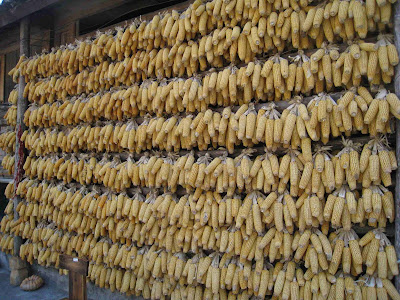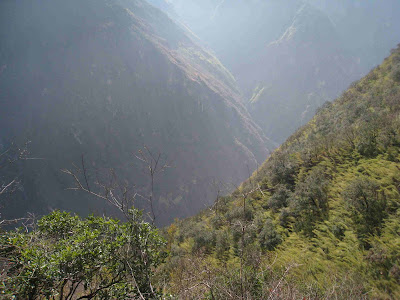
After a bowl of fresh beef noodles (the hunks of beef were hanging at the entrance to the eating place) for only Yuan 6 in Qiaotou, we were greeted by a stunning view of the Jade Snow Mountain (5,596 meters) as we set off on the hike. The Yangtze River, a bright blue for a change (it looks the color of slate in Wuhan and chocolate brown in Shanghai), snaked far below. We walked in the shade of the Haba Snow Mountain (5,400 meters).
The map showed a forbidding near vertical climb to the Naxi Family Guest House where we had planned to stay the night. We saw no other hikers, only mule drivers offering rides. They were a nuisance on the narrow path and Haba fended them off. Before long, my weakened state (I am diabetic) began to show and the climb became too hard for me. I lay down on a flat rock to rest, and, despite Haba's efforts, a mule driver refused to leave our side. He knew I was done for. His persistence paid off because I decided to ride the mule up to the Guest House (GH).
The Naxi Family Guest House turned out to be a treat. I walked into a lovely courtyard hung with drying corn, and a comfortable room heated by an electric blanket. The bathroom was clean and hot water flowed. The cost: only Yuan 130. Haba got a free room.
Haba suggested that I hire the mule the next morning as the path would be steep, so we asked the mule driver to arrive at 9.30am. His payment was Yuan 100. After a simple and delicious dinner and a hot shower, I went to bed exhausted.
I walked out just after 8.00am and saw the mule tethered outside the GH. The mule driver had turned up early, just to make sure that we wouldn't give him the slip. After a delicious breakfast that included pancake with walnuts and honey, we started off with me on the mule. Although I kept nearly sliding off the saddle due to the steepness of the trail, I was glad to be riding and not walking.
On my trusty steed! The mule driver was a 46-year old local Naxi. He has two children, with one at university.
At the highest point on the trail at 2,900 meters. The Haba Snow Mountains to my right and the Jade Snow Mountains behind me. I got off the mule here and sent the driver + mule back. Payment: Yuan 200.
Some shady trees. Haba says that local tribes are illegally felling trees here. We did see some freshly cut pine logs on the path. We didn't see any birds or wild animals. They may all have been hunted and eaten.
The path was only about 30 centimeters wide in some areas. The scenery was always breathtaking but I had to pause to enjoy it.
Many hikers have fallen off the path and been injured or killed. Haba mentioned a Korean tour guide who had fallen off while answering his cell phone. He was killed and the recovery of his body had cost a tidy sum. Young Israelis, fresh from army service, have also been victims.
Taking a welcome "Snickers" break.
The Yangtze receding below.
The Tea Horse Trade GH in Ya Cha village. Below, the family playing cards in the courtyard and enjoying the sunshine.
I had lunch at the GH and also got a rather mediocre foot massage here. They had a building called the "Thai Spa" but couldn't give me a proper foot massage, Chinese style. But, the family and other hangers on were full of cheer and I enjoyed the two hours we spent with them.
A lonely shepherd sitting at the edge of the ravine enjoying the view (I hope). Life here must be tough. All the locals we saw looked deeply tanned by the sun (almost blackened) and weatherbeaten.
The trail from Qiaotou to Halfway House appeared to be sparsely traveled. Over two days of hiking, we passed only two other hikers, an American couple who are college teachers in Kunming.
I was in the first floor room in the center. The bed was comfortable but the toilet was leaking and stank of urine. In the morning, there was no hot water for a much needed shower. The surly young manageress would not listen to complaints.
I had read that the Half Way GH would be noisy. Indeed, many young backpackers, both Chinese and Korean college students on vacation, turned-up for cheap dorm beds. They had climbed up the trail from Tina's GH and were going down the same way. But they hardly made any noise. We had long chats with Korean students both over dinner and b'fast.
As we set off the next morning, a view of snow on Haba Mountain, a rare sight according to my guide Haba.

The trail was mostly downhill from Ben Di Wan, but it became even more treacherous. In wet weather, the trail would become slippery and very dangerous. Some frisky Chinese college students were also hiking with us. They didn't seem to be aware of the dangers and kept running up and down the path, making me quite nervous.
The signs painted on rocks along the path were occasionally misleading. For instance, after passing a sign that said "Tina's 30 minutes", we passed another sign saying "Tina's 1 hour".

Resting within view of Tina's GH. I thought the hardest part of the hike was over. How wrong I turned out to be.

After a light lunch at Tina's (Haba likes potatoes fried with beef, a dish I also began to enjoy), we set off on the nearly vertical path down to the river. I thought it would be difficult, but it turned out to be the most dangerous part of the hike. In various places, there were chains, wires, roots, and branches I could hang on to, and Haba carefully guided me down. The nearly kilometer path took us about an hour and I took my sweater and jacket off because it became warm. (More from nervousness, I guess!)
We also passed the astonishing sight of a well built man being carried up on a sedan chair by two locals, who looked rather scrawny and heavily sunburned. The man said he "felt hot" at the bottom of the ravine so decided to be carried up.

We passed a number of shacks where drinks and snacks were being sold. I wonder how much these people could earn on a typical day in Winter, when only a few people would be hiking down to the river.

The bridge is near Tina's GH, and indicates how far down we had come.
The river, finally, at the Middle Tiger Leaping Gorge.
We were bothered by people who were asking for money for "maintaining the trail". One woman demanded Yuan 10 and after an argument, which could have turned nasty, I paid Yuan 2.
Instead of climbing vertically back to Tina's, I decided to go diagonally on to Walnut Garden village, which sounded inviting. Although the trail wasn't steep, it was narrow and dangerous in parts. In the section seen below, we had to walk bent in half.
In these areas, someone had maintained the trail well, erecting rustic fences or a thick metal wire to hold on to. I later met the man, thanked him for his work, and paid him the Yuan 10 that he requested. We were the only hikers to pass thru that day.
Not dead yet, only exhausted! Trying to get some oxygen into my brain.
As we came up the rugged trail, I saw this refreshing view of Walnut Garden village over a green field of wheat.
A lovely brook.
A bull and a horse tethered in a backyard. The villagers appeared to be subsistence farmers and they all had some chickens, goats, pigs, and a cow or two in their backyards. Even the remotest villages had electricity. Overall, they appeared to be content. After all, Beijing seemed distant: "The mountains are high and the Emperor is far away".
Woody's "Chateau", a simple GH in Walnut Garden village, came at the end of my hike. I quickly ordered a beer, soaked my tired feet in a basin of warm water, and relaxed on the deck with a pleasing view of the village at dusk.
We had a nice dinner, cooked by the owner's son and his girlfriend. He claimed to be a "better cook than his mother". We ate in the kitchen with a charcoal brazier to warm us.
The next morning, we hired a minivan for Yuan 120 to take us back to Qiaotou. When this road is fully developed within a year or so, hundreds of thousands of tourists will drive all the way to the Lower Tiger Leaping Gorge. I hope the thrill of the hike along the upper path will remain for many more years to come.
























































No comments:
Post a Comment